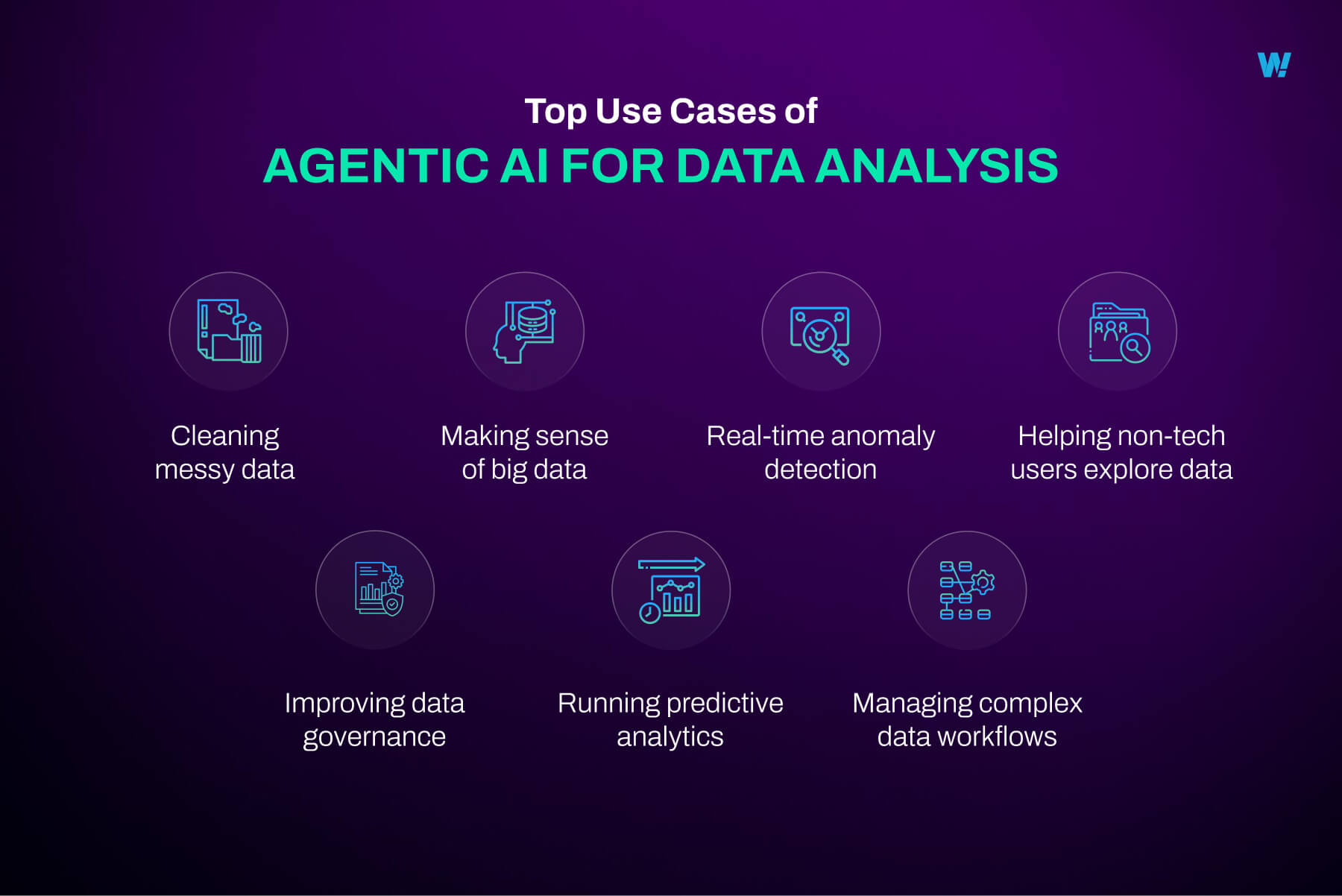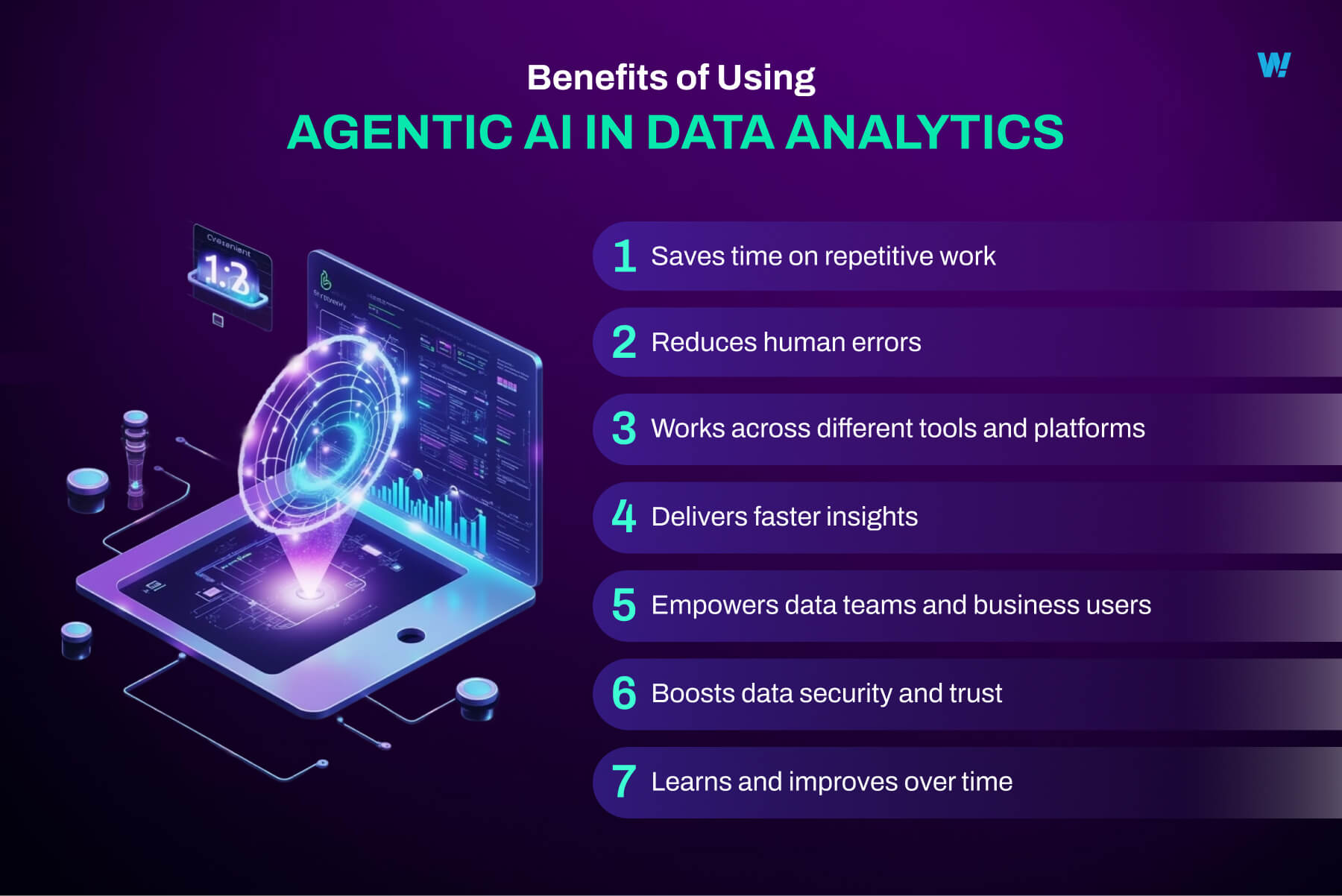Agentic AI for data analysis is helping data professionals handle complex tasks like data preparation, data governance, and data analytics with ease. AI agents can work across multiple systems to process raw data, manage structured data, and maintain data consistency—all with minimal human intervention.
These agentic AI systems support everything from data pipelines and anomaly detection to data quality, data security, and overall data operations. They offer actionable insights, improve data integrity, and simplify data discovery even in complex workflows.
One key feature in many agentic AI tools is Natural Language Interfaces (NAA). This allows users to ask questions or give commands in simple language, making data exploration faster and more accessible—even for non-technical users.
Powered by large language models, machine learning, and generative AI, these intelligent agents go beyond traditional AI and traditional analytics. They analyze data streams, uncover statistically significant findings, and work across different data platforms to help teams make better decisions using both historical and live data.
As more organizations begin implementing agentic AI for data, the global market is rapidly expanding, from USD 3.66 billion in 2023 to USD 139.12 billion by 2033, with a CAGR of 43.88%.
So in this blog, we’ll explore how agentic AI is used in data analysis, the types of AI agents involved, and the key benefits it brings to modern data teams.
What Are AI Agents in Data Analysis?
AI agents in data analysis are systems designed to help people work with large amounts of data. They don’t just organise information, they also find patterns, suggest insights, and take action. These agents can understand goals, decide what steps to take, and carry out tasks on their own.
They are useful for anyone working with data, whether in finance, marketing, healthcare, or research. AI agents can make data analysis faster, more accurate, and easier to understand.
What Can AI Agents Do in Data Analysis?
AI agents can handle many parts of the data analysis process. They are especially helpful with tasks that are repetitive, time-consuming, or require quick decisions.
Common tasks include:
- Cleaning and preparing raw data
- Spotting errors or missing values
- Creating reports and dashboards
- Highlighting unusual patterns or trends
- Recommending next steps based on insights
- Checking if data follows company policies
How Do They Work Across Systems?
In most companies, data is stored in many places spreadsheets, dashboards, databases, or cloud platforms. AI agents can connect to all these systems, gather data, and complete tasks across them. They do not need manual switching between platforms.
For example, an agent could pull data from a sales dashboard, compare it with inventory reports, and alert a manager if something looks off all automatically.
Key Components of Agentic AI Systems for Data
1. Natural Language Interfaces for Ease of Use
A big reason why agentic systems are becoming popular is that they are easy to talk to. Instead of writing code or using complex dashboards, users can ask questions or give instructions in plain English. This is made possible by natural language interfaces.
For example, a data analyst can type: “Find the top-performing regions in the last quarter,” and the AI agent will understand the request, search the right datasets, and present a clear answer—sometimes even with charts or tables.
Why this matters:
- Makes data tools more accessible to non-technical users
- Saves time by removing the need for manual queries
- Encourages more people across the business to use data in their decisions
2. Integration with Data Pipelines and Legacy Systems
Data lives in many places—CRM tools, spreadsheets, cloud databases, internal servers, and even older platforms. For an agentic system to work well, it must connect to all these sources. This is called integration.
By linking to the existing data pipeline and legacy systems, the agent can collect information from multiple places, combine it when needed, and act on it. It doesn’t ask users to move data around or switch tools—it fits into the flow you already have.
Why this matters:
- Allows smooth use of the agent without overhauling your systems
- Keeps costs low by working with tools already in place
- Reduces time spent switching between platforms
3. Data Catalogue, Lineage, and Governance Agents
Good data work depends on knowing where your data comes from, who can use it, and how it’s being used. Agentic systems often include built-in agents for data cataloguing, lineage tracking, and governance.
A data catalogue helps list and describe all the datasets your business has.
Lineage tracking shows how the data has changed over time, what was added, updated, or removed.
Governance agents make sure that only the right people have access, and that rules (like GDPR or internal policies) are followed.
Why this matters:
- Helps users trust the data they are working with
- Makes it easier to trace errors or changes back to the source
- Ensures safe and legal use of company or customer data
4. Decision-Making and Automation Without Constant Human Input
Unlike basic tools that need a human to guide every step, agentic AI systems can make decisions and take action on their own. You give the agent a goal, like “check for unusual drops in website traffic” and it figures out what steps to take, runs the analysis, and delivers the result.
If needed, it can even go further such as alerting the marketing team or adjusting a dashboard without anyone asking.
Why this matters:
- Speeds up decision-making and response times
- Frees up data teams from routine, repetitive work
- Allows teams to focus on strategy, not small tasks
5. Monitoring Data Trust, Consistency, and Integrity
An agent is only as good as the data it works with. That’s why one of the most important components of an agentic system is its ability to monitor data quality.
The system checks for missing values, outdated records, broken links between datasets, or mismatches in format. It does this continuously in the background. When it finds something wrong, it can either fix it automatically or alert a user to review it.
Why this matters:
- Prevents poor-quality data from affecting decisions
- Ensures that reports and insights are reliable
- Builds long-term trust in the use of AI for data work
Top Use Cases of Agentic AI for Data Analysis

Agentic AI is changing the way we work with data. Instead of spending hours on manual tasks, data teams can now rely on intelligent agents to take over routine work, offer insights, and even make decisions. Below are some of the most valuable ways agentic AI is being used in data analysis today.
1. Cleaning Messy Data
Raw data often comes with problems, missing values, duplicate entries, or formatting issues. AI agents can clean this data automatically. They detect errors, fill in gaps using logic or past patterns, and get the data ready for deeper analysis.
Why it matters:
Saves time spent on manual data prep
Increases the accuracy of reports and dashboards
Makes data easier to work with from the start
2. Making Sense of Big Data
Large datasets can be overwhelming, even for experienced analysts. Agentic AI can scan through vast amounts of information quickly and find what matters, whether it’s hidden trends, outliers, or key performance patterns.
Why it matters:
- Helps spot things that humans might miss
- Speeds up time to insight
- Supports better decision-making with clearer evidence
3. Real-Time Anomaly Detection
In fast-moving environments, spotting issues quickly is crucial. AI agents can monitor live data streams and flag anything unusual like a sudden drop in sales or a potential security threat.
Why it matters:
- Detects problems as they happen
- Reduces risks such as fraud or system failures
- Allows quick action before issues grow
4. Helping Non-Tech Users Explore Data
One of the most powerful features of agentic AI is its ability to work with plain language. Business users don’t need to know coding or SQL. They can simply ask questions like “What were our top-selling products last week?” and the AI fetches the answer in seconds.
Why it matters:
- Makes data accessible to more people in the organisation
- Encourages a data-driven culture
- Reduces pressure on technical teams
5. Improving Data Governance
Agentic systems include specialised agents that look after data quality and security. These agents track where data comes from, ensure it follows company rules, and flag any issues with access or consistency.
Why it matters:
- Builds trust in your data
- Supports legal and policy compliance
- Prevents errors from spreading through systems
6. Running Predictive Analytics
AI agents can go beyond analysing past data, they can also predict what’s likely to happen next. By using machine learning, they identify patterns and forecast outcomes, such as customer behaviour, sales trends, or equipment problems.
Why it matters:
- Helps teams plan ahead with confidence
- Supports better decisions based on likely scenarios
- Reduces uncertainty in fast-changing environments
7. Managing Complex Data Workflows
Modern data workflows often involve many steps, collecting data, cleaning it, analysing it, and then reporting results. Agentic AI agents can manage these steps across systems, keeping everything running smoothly without much human help.
Why it matters:
- Saves time by automating routine tasks
- Keeps workflows consistent and efficient
- Allows data professionals to focus on higher-level work
Benefits of Using Agentic AI in Data Analytics

1. Saves Time on Repetitive Work
Data professionals often spend hours on routine tasks, cleaning spreadsheets, updating reports, or sorting through records. AI agents can take over these jobs. They work in the background, handling repetitive steps and freeing up time for deeper analysis and strategy.
Why it matters:
- Reduces manual workload
- Speeds up day-to-day processes
- Allows teams to focus on high-value tasks
2. Reduces Human Errors
Manual data work often leads to mistakes, especially when done at scale. Agentic AI brings greater accuracy and consistency. Once trained, these agents follow clear rules and double-check their own work.
Why it matters:
- Improves the quality of reports and dashboards
- Reduces risk caused by incorrect data
- Builds confidence in decision-making
3. Works Across Different Tools and Platforms
Many teams use a mix of tools, modern apps, old systems, cloud services, and spreadsheets. AI agents can connect with all of them. They move between platforms, collect the right data, and act without needing humans to switch systems.
Why it matters:
- Keeps data flowing smoothly across departments
- Avoids delays caused by tool limitations
- Makes better use of your existing systems
4. Delivers Faster Insights
Waiting for reports can slow down decisions. With agentic AI, insights arrive in real time. The agent tracks data as it changes, highlights trends, and shares alerts or summaries without delay.
Why it matters:
- Supports faster, data-driven decisions
- Keeps teams updated with fresh insights
- Helps businesses react quickly to change
5. Empowers Data Teams and Business Users
Not everyone on a team is a data expert. With agentic AI, even non-technical users can ask questions in simple language. The agent handles the search, analysis, and formatting, then presents results in an easy-to-understand way.
Why it matters:
- Opens up data access across the company
- Encourages everyone to use data
- Reduces pressure on the data team
6. Boosts Data Security and Trust
Agentic systems often include built-in governance agents. These agents keep an eye on data sources, control access, and make sure rules are followed. They also help document changes and maintain clean records.
Why it matters:
- Protects sensitive information
- Supports compliance with data policies
- Builds long-term trust in your data systems
7. Learns and Improves Over Time
These agents don’t stay the same. With reinforcement learning and regular user feedback, they adapt and become better. Over time, they learn your preferences, improve their suggestions, and handle tasks more efficiently.
Why it matters:
- Gets smarter with regular use
- Provides more accurate insights
- Supports continuous improvement
How to Implement AI Agents in Your Data Workflows
To make the most of agentic AI, it’s important to set up your systems carefully. Below is a step-by-step guide that shows how to bring AI agents into your existing data workflows, one stage at a time.
1. Identify Repetitive and Complex Tasks
Begin by listing the tasks that are repeated often or take up too much time. These might include cleaning data, sending regular reports, answering common queries, or checking for errors. These are ideal areas where AI agents can take over.
This helps you focus on areas where AI will have the biggest impact from the start.
2. Select the Right Agent Framework
Choose a platform or framework that fits with the tools your team already uses. Look for systems that are modular, flexible, and easy to integrate with your data sources—like your databases, cloud tools, or analytics software.
This ensures a smoother setup and avoids the need to replace existing systems.
3. Train the AI Agents
Once you’ve chosen your system, the next step is to train it using your own data. This might include past reports, customer queries, logs, or business rules. The agent learns how your organisation works, and how to respond to common patterns or needs.
Training the agent this way helps it deliver results that match your expectations.
4. Enable Natural Language Interaction
Set up a simple interface where users can type their questions or requests in everyday language. This makes the agent useful for more people across your team—not just data experts. For example, someone might ask, “What were sales like last quarter?” and get a quick answer.
This encourages wider use and makes data analysis more accessible across departments.
5. Integrate with Your Data Pipeline
Connect the agent to the full flow of your data—from when it is first collected to where it’s stored, analysed, and shared. This includes linking it with dashboards, spreadsheets, APIs, and cloud storage.
Once connected, the agent can move through your systems and carry out tasks automatically.
6. Monitor Performance and Accuracy
After your agent goes live, keep track of how well it’s performing. Review the insights it provides, check the reports it produces, and listen to feedback from your team. You may need to fine-tune its settings or update its access to data.
Regular monitoring helps keep the agent accurate and useful over time.
7. Scale and Improve Over Time
As your team gains confidence in using AI agents, you can expand their use. Add new tasks, connect more data sources, or use different agents for different teams. The system can grow with your organisation.
This allows you to get even more value as your data needs increase.
Want to Build Your Own AI Agent?
Whether you’re just starting with AI or looking to scale your data systems, building your own AI agent can transform how your team works. From cleaning messy data to delivering insights in seconds, agents are not just useful; they’re becoming essential.
The good news? You don’t have to do it alone.
How Wow Labz Can Help You
At Agentic AI Labz by Wow Labz, we help companies like yours design and build powerful, reliable AI agents that fit your exact needs.
We don’t believe in one-size-fits-all. We custom-build every agent, trained on your data, aligned to your workflows, and designed to grow with your team.
Our solutions are already powering data teams, marketers, and product leaders across industries.
And our clients love the results. From smoother operations to faster decision-making, the feedback speaks for itself.
So if you’re ready to unlock the full potential of AI in your data workflows…
Connect with us and let’s build something that works for you and keeps getting better.






